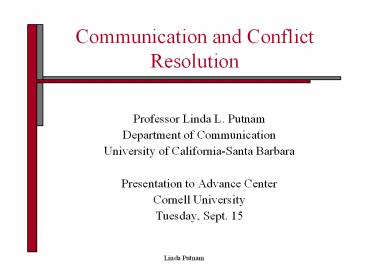Communication and Conflict Resolution - PowerPoint PPT Presentation
1 / 18
Title:
Communication and Conflict Resolution
Description:
Title: Effective Conflict Management Author: Tom Putnam Last modified by: Linda Created Date: 10/24/2001 4:58:14 AM Document presentation format: On-screen Show – PowerPoint PPT presentation
Number of Views:145
Avg rating:3.0/5.0
Title: Communication and Conflict Resolution
1
Communication and Conflict Resolution
- Professor Linda L. Putnam
- Department of Communication
- University of California-Santa Barbara
- Presentation to Advance Center
- Cornell University
- Tuesday, Sept. 15
2
Prevalence of Conflict in the Workplace
- Managers spend 60 of time related to personnel
issues, requests, and problematic situations - Organizational concerns for voice, fairness, and
managing grievances - Innovations and change typically entail some
degree of conflict or resistance
3
Overview of Presentation
- Definition, key assumptions, and role of
communication in conflict - Distinctions between dysfunctional and functional
conflicts - Overview of 2nd generation gender issues
- Approaches and guidelines for effective conflict
management
4
Definition of Conflict
- Social interaction of two or more interdependent
parties who perceive incompatible goals
5
Characteristics of Conflict
- Perceived incompatibilities
- Expressed struggle
- Interdependence of parties
- Simultaneous cooperation and competition
- Potential interference or blocking of goals
6
Misperceptions and Assumptions about Conflict
- Conflict is not evil it is the normal state of
affairs - The best metaphor of conflict is a dance or a
dialogue, not a war - People should develop a repertoire of approaches
for managing conflicts
7
Role of Communication in Conflict Management
- Conflict interaction
- Evolves in stages
- Acquires a momentum of its own
- Becomes cyclical or patterned
- Can escalate or de-escalate
- Is linked to relationships and past communication
patterns
8
Destructive or Dysfunctional Conflict
- Characterized by
- Growth in issues, parties, and costs
- Blurred and distorted issues
- Frequent emotional eruptions
- Parties become inflexible
- Decreased communication
9
Constructive or Functional Conflict
- Characterized by
- Defining and clarifying the problem
- Uncovering needs and interests
- Generating and prioritizing options
- Engaging in a dialogue
- Enhancing mutual understanding
10
Second Generation Gender Issues
- Gender as a socially organized construction
- Distinction between 1st and 2nd generation gender
issues - Types of 2nd generation gender issues
- Ideal workerwork-family conflicts
- Gendered workwork assignment conflicts
11
Research Findings on Work-Family Conflicts
- Inconsistent link between availability of company
practices and reduction of work-life conflict - Frequent use equals perceived greater conflict
- Differential effects across organizational levels
- Knowledge of policies varies
12
Research Findings on Work-Family Conflicts
- Factors that reduce work-family conflicts
- Supportive supervisors
- Supportive organizational cultures
- Amount of autonomy and control over the job
- Ability to alter patterns of work overload
13
Research on Gender Work Conflicts
- Reduction in perceptions of gender work
assignments are related to - Agency or authority to raise issues
- Perceived influence
- Proactive rather than reactive approaches
14
Effective Conflict Management Approaches
- Develop a repertoire of interpersonal strategies
and styles - Avoidance
- Smoothing
- Competing
- Compromise
- Problem Solving
15
Effective Conflict Management Approaches
- Attend to the shadow or background of conflict
- Position self in the conflict
- Enlisting alliesseed ideas early
- Focus on framing and reframing
- Use appreciative movessave the other partys
face
16
Framing and Reframing the Conflict
- Namingwhat is this conflict about?
- Explaininghow do I explain it?
- Blaminghow am I assessing blame?
- Claimingwho owns it?
17
Alter or Change the Story
- Ways to describe events, occurrences, and parties
- Key elements of stories
- Ways that stories are similar and different
- Moral of the story
- Elements missing in the story
18
Overall Guidelines for Conflict Management
- Dialogueseek common ground
- Empathycast the conflict in the other persons
terms - Discover underlying interests
- Redefinechange focus or definition of the
problem - Avoid escalation































